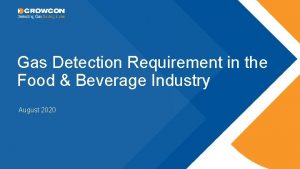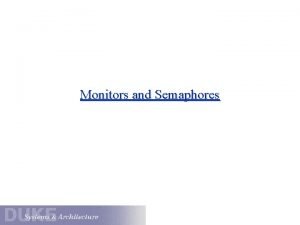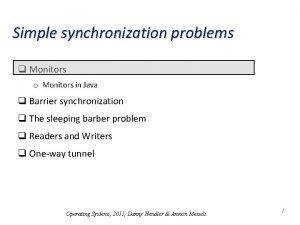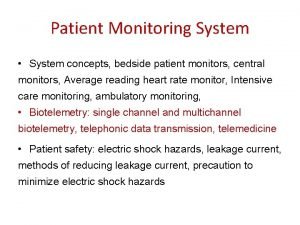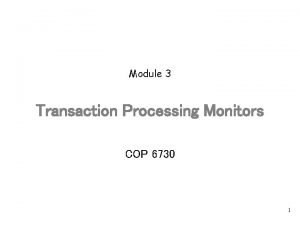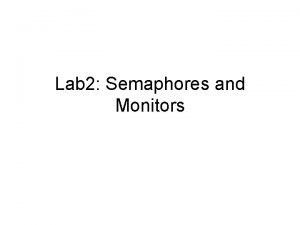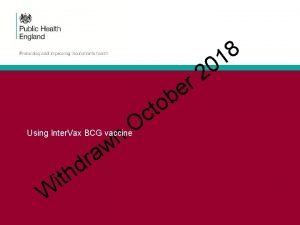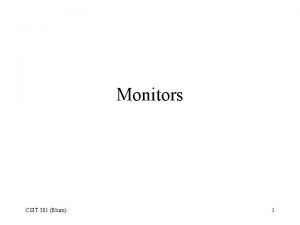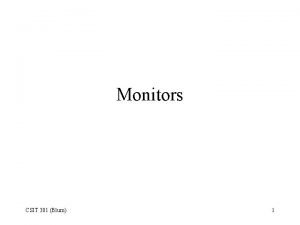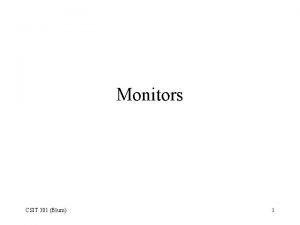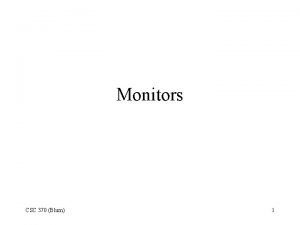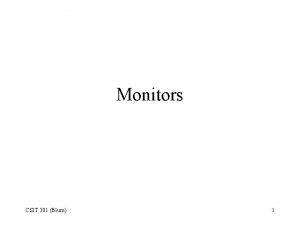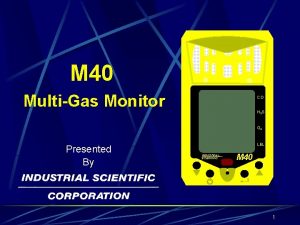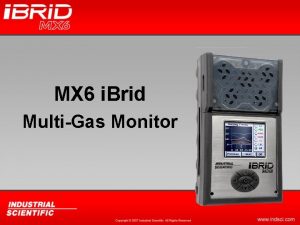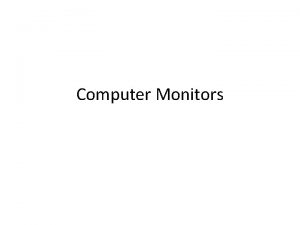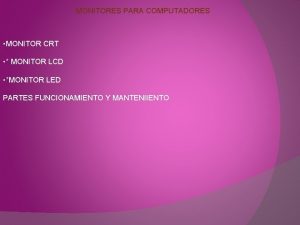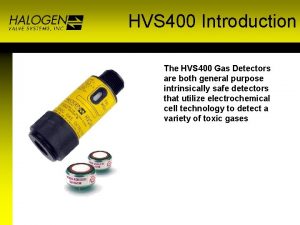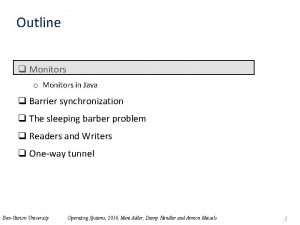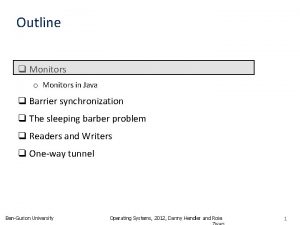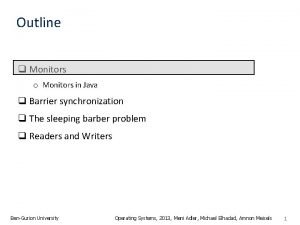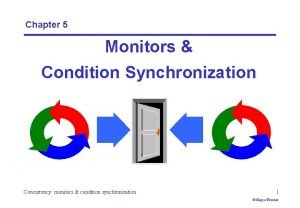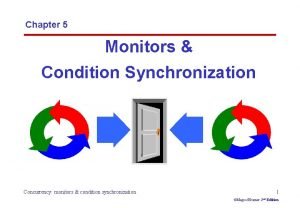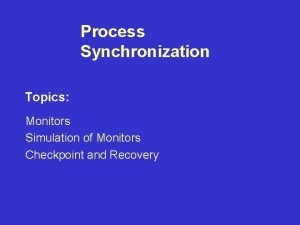Multigas Monitors P 400 Gas Monitor Eng Hatem






























- Slides: 30

Multigas Monitors P 400 Gas Monitor Eng Hatem



Multigas Monitors • Multigas monitors are capable of measuring a number of gases simultaneously with results displayed continuously. The gases monitored and displayed can include Flammable, Oxygen, Carbon Monoxide, Hydrogen Sulphide, and Carbon Dioxide. Audible and visual alarm is provided making the monitors suitable for deployment in the confined space or as perimeter guard for protection and warning.

Municipal Operations • Water treatment plants • Sewer plant operations • Confined space

Basic Air Monitoring • Each of the previous situations could benefit from air monitoring. • Detectors are generally used to determine: – Oxygen content – Presence of flammable vapors or gases – Presence of toxic materials • Terms pertaining to characteristics of materials for which monitoring might be used should be discussed first.

Hazard Property Terms • IDLH: Immediately dangerous to life and health values • Exposure Limits: OSHA PEL: permissible exposure limits • TWA: Time weighted average limits expressed in PPM which should not be exceeded during an 8 hour work shift in a 40 -hour work week • PPM: Parts per million. Can be converted into percentage by volume by dividing the PPM given by 10, 000.

Oxygen Deficiency

Composition of fresh air • 78. 1 % Nitrogen • 20. 9 % Oxygen • 0. 9 % Argon • 0. 1 % All other gases • Water vapor • CO 2 • Other trace gases

Oxygen Enrichment • Proportionally increases the rate of many chemical reactions • Can cause ordinary combustible materials to become flammable or explosive

Causes of Oxygen Deficiency • Microbial action • Oxidation • Combustion

Symptoms of Oxygen Deficiency 19. 5 % 15 - 19% Minimum acceptable oxygen level. Decreased ability to work strenuously. Impair coordination. Early symptoms. 12 -14% Respiration increases. Poor judgment. 10 -12% Respiration labored. Lips blue. 8 -10% Mental failure. Fainting, Nausea, Unconsciousness, Vomiting. 6 -8% 4 -5 minutes - possible recovery, 6 minutes - 50% fatal, & 8 minutes fatal. 4 -6% Coma almost instantaneously. Death

Carbon Monoxide

What Is Carbon Monoxide? • CO is a compound of Carbon and Oxygen • One atom carbon to one atom oxygen • Colorless • Odorless • Tasteless • POISONOUS Gas

Where Does It Come From? • CO is Produced by the Incomplete Combustion of Various Fuels (Hydrocarbons) , Including: Coal Wood Charcoal Oil Kerosene Propane Natural Gas Note production of CO from the fire on right

Common Sources of Carbon Monoxide Pollution WATER HEATERS & FURNACES FIREPLACES

Sources (Cont. ) VEHICLE EXHAUST SMOKING INDOORS

More Sources. Common in Power Outages PORTABLE GENERATORS PORTABLE PROPANE HEATERS

The Hidden Dangers of CO • Carbon Monoxide Poisoning is the Most Common Exposure Poisoning in the United States • Carbon Monoxide is Not Easily Recognized Because the Signs and Symptoms Are Similar to Those of Other Illness • This Odorless, Colorless Gas Can Cause Sudden Illness and Death

Action Levels- Lower Limits • 0 to 9 ppm- Normal • No Action: Typically from multiple potential sources • 10 to 35 ppm- Marginal • This level could become problematic • Actions: Occupants should leave the building and be advised of a potential health hazard to small children, elderly people and persons suffering from respiratory or heart problems • Find source and mitigate/fix problem

Action Levels- Medium Limits • 36 to 99 ppm- Excessive: Medical Alert • Conditions must be mitigated • Actions: Ask occupants to step outside and query about health symptoms • Call 911 • Contact Gas Company and/or Contractor • Advise occupants to seek medical attention • If occupants exhibit any symptoms of CO poisoning, they should be immediately transported to a medical facility • Preferably by ambulance • Professionals Required From this Point On • Fire/EMS • Gas Company/Contractor

Action Levels- Higher Limits • 100 – 200 ppm- Dangerous: Medical Alert • Emergency conditions exist • Actions: Evacuate the building immediately and check occupants for health symptoms • All occupants Should Be Evaluated by EMS Personnel • If occupants exhibit any symptoms of CO poisoning, they should be immediately transported to a medical facility • Preferably by ambulance • Greater than 200 ppm- Very Dangerous: Medical Alert • Actions: Same as Above

Symptoms of CO Poisoning • ANY OR ALL OF: • Headache • Dizziness • Irritability • Confusion/Memory Loss • Disorientation • Nausea and Vomiting • Abnormal Reflexes • Difficulty in Coordinating • Difficulty in Breathing • Chest Pain • Cerebral Edema • Convulsions/Seizures • Coma • Death

Exposure Routes: inhalation, skin and/or eye contact (liquid) Symptoms: Headache, tachypnea, nausea, lassitude (weakness, exhaustion), dizziness, confusion, hallucinations; cyanosis; depressed S-T segment of electrocardiogram, angina, syncope Target Organs: cardiovascular system, lungs, blood, central nervous system

Hydrogen Sulfide is an extremely toxic gas that is colorless, flammable, heavier than air, soluble in water, and has the smell of rotten eggs at lower concentrations. At higher concentrations H 2 S can deaden your sense of smell. H 2 S

Hydrogen Sulfide is formed under low oxygen conditions when sufficient amounts of sulfur and bacteria are present. H 2 S can be formed in many places such as: Oil and gas reservoirs Sewers and sewage processing facilities Dark damp places where bacteria is present.

Exposure Limits Permissible Exposure Limit: 10 ppm for an 8 -hr period avg. Short Term Exposure Limit: 15 ppm for a 15 -minute avg. Immediately Dangerous to Life or Health: 100 ppm.

The following table below lists the health effects of exposure to H 2 S. Concentration Health Effects 10 ppm Beginning eye irritation 50 -100 ppm Slight respiratory tract irritation after 1 hour exposure. 100 ppm Coughing, eye irritation, loss of sense of smell after 2 -15 minutes. Altered respiration, pain in the eyes, and drowsiness after 15 -30 minutes followed by throat irritation after 1 hour. Several hours exposure results in gradual increase in severity of these symptoms and death may occur within the next 48 hours 200 -300 ppm 500 -700 ppm Severe respiratory tract irritation after 1 hour of exposure. Possible pulmonary edema (fluid in the lungs). Loss of consciousness and possibly death in 30 minutes to 1 hour. 700 -1, 000 ppm Rapid unconsciousness, loss of respiration, and death after 1 -3 minutes. 1, 000 -2, 000 ppm Unconsciousness at once, loss of respiration and death in a few minutes. Death may occur even if individual is removed to fresh air at once.

Symptoms of Exposure q Burning Eyes q Sore Throat q Respiratory Irritation q Coughing q Headache q Dizziness q Nausea Fatigue q Confusion q Loss of Sense of Smell.

 200 + 200 = 400
200 + 200 = 400 Kalbül ceyş
Kalbül ceyş Eng katta va eng kichik qiymatlari
Eng katta va eng kichik qiymatlari Food & beverage gas safety monitors
Food & beverage gas safety monitors Plasma display technology
Plasma display technology Perkembangan monitor
Perkembangan monitor Msa gas monitor
Msa gas monitor Teknologi display
Teknologi display Identifies, selects, monitors, and evaluates sales channels
Identifies, selects, monitors, and evaluates sales channels Piddling manufacturing assembles security monitors
Piddling manufacturing assembles security monitors Monitor condition variable
Monitor condition variable Graphics monitors and workstations
Graphics monitors and workstations What are monitors and condition variables?
What are monitors and condition variables? Sleeping barber problem using monitors
Sleeping barber problem using monitors Monitors
Monitors Sleeping barber problem using monitors
Sleeping barber problem using monitors Cop is a transaction processing system
Cop is a transaction processing system Which organization monitors interstate fish shipments?
Which organization monitors interstate fish shipments? Citra two monitors
Citra two monitors The main disadvantage of semaphore definition is
The main disadvantage of semaphore definition is Semaphores and monitors
Semaphores and monitors Classic problems of synchronization
Classic problems of synchronization Https://ihtusa.com/
Https://ihtusa.com/ Vaccination xard
Vaccination xard Monitors: an operating system structuring concept
Monitors: an operating system structuring concept Energy star monitors
Energy star monitors Reaksi pembentukan gas no2f dari gas no2 dan f2
Reaksi pembentukan gas no2f dari gas no2 dan f2 Derive ideal gas equation
Derive ideal gas equation Flue gas desulfurisation gas filter
Flue gas desulfurisation gas filter Gas exchange key events in gas exchange
Gas exchange key events in gas exchange An ideal gas is an imaginary gas
An ideal gas is an imaginary gas



